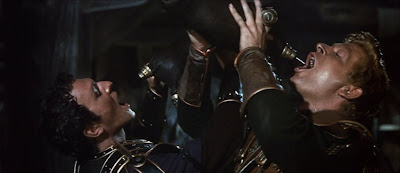Three years ago, I noted an interesting visual parallel between two scenes in William Wyler’s version of Ben-Hur (1959). In one, we see Charlton Heston and Stephen Boyd linking arms as they share a drink, in the early part of the film when they are friends; in the other, we see their chariot wheels overlapping in a similar manner, in the later part of the film when they are enemies:
Two days ago, I finally got around to seeing Anthony Mann’s The Fall of the Roman Empire (1964), and was struck by a very similar pair of images involving Stephen Boyd — again! — and Christopher Plummer. Once again, the linking and drinking when they are friends, and the chariot race with scraping wheels when they are enemies, or at least on the path to becoming enemies:
Interestingly, they say that the producers originally wanted Charlton Heston for the Boyd role in The Fall of the Roman Empire, but Heston turned it down because it would have meant sharing more love scenes with Sophia Loren, with whom he did not get along on the set of El Cid (1961). I wonder, though, if he also thought the Boyd character in this film would have been too similar to the character he played in Ben-Hur.
It is also interesting to consider that The Fall of the Roman Empire covers the last days of Marcus Aurelius and the reign of his son Commodus, and it includes both a thwarted love story of sorts between Aurelius’s daughter and the Roman general played by Boyd, as well as a climactic gladiatorial duel between Commodus and the Roman general played by Boyd. Sounds a lot like Ridley Scott’s Gladiator (2000), doesn’t it?
Except Gladiator is actually closer to Ben-Hur than The Fall of the Roman Empire is, in some respects, since both Gladiator and Ben-Hur concern protagonists who begin as rulers among men and are then brought down to the level of slaves, before they rise back up again. The Boyd character in The Fall of the Roman Empire follows a very different sort of narrative arc.
Still, the similarities are interesting, as far as they go.
















